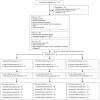Individuals with controlled hypertension show endothelial integrity following a bout of moderate-intensity exercise: randomized clinical trial
- PMID: 33879820
- PMCID: PMC8058090
- DOI: 10.1038/s41598-021-87990-6
Individuals with controlled hypertension show endothelial integrity following a bout of moderate-intensity exercise: randomized clinical trial
Abstract
To examine the acute effects of aerobic exercise (AE), resistance exercise (RE) or combined exercise (CE) on flow-mediated dilation (FMD), progenitor cells (PCs), endothelial progenitor cells (EPCs), oxidative stress markers and endothelial-cell derived microvesicles (EMVs) in patients with hypertension. This is a randomized, parallel-group clinical trial involving an intervention of one session of three different modalities of exercise. Thirty-three males (43 ± 2y) were randomly divided into three groups: a session of AE (n = 11, 40 min, cycle ergometer, 60% HRR); a session of RE (n = 11, 40 min, 4 × 12 lower limb repetitions, 60% 1-RM); or a session of CE (n = 11, 20-min RE + 20-min AE). FMD was assessed 10 min before and 10, 40 and 70 min post-intervention. Blood samples were collected at the same time points (except 40 min). FMD were similar in all groups and from baseline (within each group) after a single exercise bout (AE, RE or CE). At 70 min, RE group showed higher levels of PCs compared to the AE (81%) and CE group (60%). PC levels were reduced from baseline in all groups (AE: 32%, p = 0.037; RE: 15%, p = 0.003; CE: 17%, p = 0.048). The levels of EPCs, EMVs and oxidative stress were unchanged. There were no acute effects of moderate-intensity exercise on FMD, EPCs, EMVs and oxidative stress, but PCs decreased regardless of the exercise modality. Individuals with controlled hypertension do not seem to have impaired vascular function in response to a single exercise bout.
Conflict of interest statement
The authors declare no competing interests.
Figures




Similar articles
-
Effects of autonomic nervous system activation on endothelial function in response to acute exercise in hypertensive individuals: study protocol for a randomized double-blind study.Trials. 2021 Aug 19;22(1):548. doi: 10.1186/s13063-021-05516-x. Trials. 2021. PMID: 34412668 Free PMC article.
-
Aerobic or resistance exercise performed the previous day does not attenuate postprandial hyperglycemia-induced endothelial dysfunction in overweight/obese adults.Eur J Appl Physiol. 2019 Aug;119(8):1855-1863. doi: 10.1007/s00421-019-04174-x. Epub 2019 Jun 11. Eur J Appl Physiol. 2019. PMID: 31187279 Clinical Trial.
-
Aerobic exercise, but not isometric handgrip exercise, improves endothelial function and arterial stiffness in patients with myocardial infarction undergoing coronary intervention: a randomized pilot study.BMC Cardiovasc Disord. 2021 Feb 17;21(1):101. doi: 10.1186/s12872-021-01849-2. BMC Cardiovasc Disord. 2021. PMID: 33596832 Free PMC article. Clinical Trial.
-
The impact of different forms of exercise on circulating endothelial progenitor cells in cardiovascular and metabolic disease.Eur J Appl Physiol. 2022 Apr;122(4):815-860. doi: 10.1007/s00421-021-04876-1. Epub 2022 Jan 12. Eur J Appl Physiol. 2022. PMID: 35022875 Free PMC article. Review.
-
The impact of different forms of exercise on endothelial progenitor cells in healthy populations.Eur J Appl Physiol. 2022 Jul;122(7):1589-1625. doi: 10.1007/s00421-022-04921-7. Epub 2022 Mar 19. Eur J Appl Physiol. 2022. PMID: 35305142 Free PMC article. Review.
Cited by
-
Post-isometric exercise hypotension occurs irrespective of muscle mass in adults with hypertension: A randomized clinical trial.Clinics (Sao Paulo). 2025 Apr 16;80:100612. doi: 10.1016/j.clinsp.2025.100612. eCollection 2025. Clinics (Sao Paulo). 2025. PMID: 40245790 Free PMC article. Clinical Trial.
-
A fluid-structure interaction model accounting arterial vessels as a key part of the blood-flow engine for the analysis of cardiovascular diseases.Front Bioeng Biotechnol. 2022 Aug 19;10:981187. doi: 10.3389/fbioe.2022.981187. eCollection 2022. Front Bioeng Biotechnol. 2022. PMID: 36061431 Free PMC article.
-
Cardiac Oxidative Stress and the Therapeutic Approaches to the Intake of Antioxidant Supplements and Physical Activity.Nutrients. 2021 Sep 30;13(10):3483. doi: 10.3390/nu13103483. Nutrients. 2021. PMID: 34684484 Free PMC article. Review.
-
Exercise Training Effects on Circulating Endothelial and Progenitor Cells in Heart Failure.J Cardiovasc Dev Dis. 2022 Jul 10;9(7):222. doi: 10.3390/jcdd9070222. J Cardiovasc Dev Dis. 2022. PMID: 35877584 Free PMC article. Review.
-
Berberine: A Review of its Pharmacokinetics Properties and Therapeutic Potentials in Diverse Vascular Diseases.Front Pharmacol. 2021 Nov 3;12:762654. doi: 10.3389/fphar.2021.762654. eCollection 2021. Front Pharmacol. 2021. PMID: 35370628 Free PMC article. Review.
References
Publication types
MeSH terms
LinkOut - more resources
Full Text Sources
Other Literature Sources
Medical

